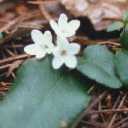Cellar Mountain Trail Guide
A detailed description of the trail during the spring
Written by
Kelly Thorlkinson
Field Biology May 1998
|
Location and Directions The Cellar Mountain Trail is a side trail off the St. Mary's Trail. Located on the Blue Ridge Parkway, the trail is 2.9 miles and is marked with a blue blaze. The trail begins off Route 42 and ends at Route 478. An exuberant hiker can follow Route 478 to Green Pond and continue on the 13 mile St. Mary's Trail hike. To drive to the Cellar Mountain Trail, drive South on Interstate 81 to the Raphine exit and turn east onto Route 56. Make the next left on State Route 608. Make the next right on Route 41. Approximately one mile down 41 make a left on Route 42. The trail will be about on and a half miles on the right.
|
|||
|
Geology The Cellar Mountain Trail climbs from an altitude of about 2000 feet to 3640 feet at the top of Cellar Mountain. The trail is located on the West Side of the Blue Ridge Mountains and therefore receives the afternoon sun. The result is the soil of the area being exceedingly dry and thin. Due to the unappealing soil, the vegetation along the trail is not very diverse. The rock of the trail is primarily sandstone. |
||
|
Map Outline of the Cellar Mountain Trail is in thick black. |
|||

 |
||||||||
|
Canopy, Understory, Shrubs, and Wildflowers |
||||||||
| Canopy
The canopy of the Cellar Mountain Trail is primarily made up of Pine Trees and Chestnut Oak Trees. The Chestnut Oak tree is the dominant tree of the trail and, because of its large leaves, does not allow for a large number of understory trees and shrubs. These trees enjoy the afternoon sun that hits the West Side of the mountain and grow well in the rocky sandy soil.
|
||||||||
|
Understory The understory of the Cellar Mountain Trail consists of Sour Gum Trees and American Chestnuts. At one point, the American Chestnut would have probably been the most dominant tree in the Blue Ridge Mountains but due to the Chinese Chestnut blight, it will never reach adulthood in present times. There are a large number of American Chestnut Trees along the trail but the Sour Gum Tree seems to be only in places where it is guaranteed to receive the most amount of sun under the canopy leaves. American Chestnut The American Chestnut grows approximately five feet before being infected with the blight. Therefore, you will see small American Chestnut trees all along the trail. The trees are very apparent at the beginning of the trail and slowly fade away as soon as more pines come in as you go up the mountain. |
||||||||
 |
||||||||
|
Shrubs The trail has distinct large shrubs as well as some smaller shrubs. All along the trail, bunches of blueberry bushes attract the hiker's attention. Though even in May it seems as if the berries have already come and gone, the leaves are turning from green to violet. Other shrubs seen along the trail include Mountain Laurels and Pink Azaleas. These shrubs can grow very high and have evergreen leaves.
|
||||||||||||||
 |
||||||||||||||
|
Ferns The ferns seen along the trail are Bracken Fern and the Cinnamon Fern. The Cinnamon Fern can be spotted in a large bunch approximately a quarter of a mile up the trail right before a small stream that bisects the trail. This fern is very hairy, prefers wet soil, and has a head that looks like a fiddle right before blooming. In the spring, hikers will see these ferns in bloom. |
||||||||||||||
|
The wildflowers along the trail are often ones that do not need rich soil to grow. These include the Birdfoot Violet, the Sessile-leafed Bellwort, Trailing Arbutus, Wintergreen, the Crested Iris, and some Yellow Stargrass. With exception of the Wintergreen and the Trailing Arbutus, the wildflowers are found in small groups and are often only seen once or twice on the way up the mountain. Only one or two single plants of Yellow Stargrass are seen along the trail as well. The Birdfoot Violet, the Sessile-leafed Bellwort, the Crested Iris, and the Yellow Stargrass were all in bloom. This is not a favored hike for a wildflower fan. |
||||||||||||||
 |
||||||||||||||
|
Trailing Arbutus The Trailing Arbutus is found all along the trail especially right where the edges of the trail meet the forest. The Flower is not in bloom in early spring.
|
||||||||||||||
| Sessile-leafed Bellwort
The Sessile-leafed Bellwort is found in a few small groups on the trail. |
||||||||||||||
| Wildlife
It is easy to find wildlife on the Cellar Mountain Trail without even looking. Birds that are often in the area include Turkey Vultures using their extremely high sense of smell to look for food. The first half mile or so up the trail, hikers can find three ant mounds; two is use and one abandoned. It is not advisable to get too close. Lonely ants tend to find new homes in hiker's pants. Frogs are also seen along the trail is one looks close enough but it difficult to tell the species. |
||||||||||||||
Sources
Pictures used in creating this website are from:
Brockman, Frank Trees of North America: A Guide to Field Identification. Western Publishing Company, New York 1968.